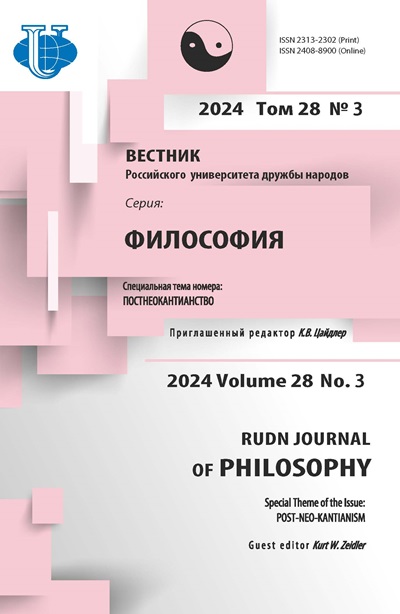On the European Roots of the Identity Crisis in Japanese Aesthetics of the ХХ-ХХI centuries
- Authors: Skvortsova E.L.1
-
Affiliations:
- Inst Institute of Oriental Studies of the Russian Academy of Sciences
- Issue: Vol 28, No 3 (2024): POST-NEO-KANTIANISM
- Pages: 833-847
- Section: HISTORY OF EASTERN PHILOSOPHY
- URL: https://journals.rudn.ru/philosophy/article/view/40995
- DOI: https://doi.org/10.22363/2313-2302-2024-28-3-833-847
- EDN: https://elibrary.ru/WKVCMK
Cite item
Full Text
Abstract
During the second half of the 20th century aesthetical students in Japan demonstrated growing activity, aimed at the investigation in the field of national aesthetical heritage applying the method of hermeneutics. The Western forms of philosophical thought and comparative studies were supposed to be necessary for this purpose. But there appeared a group of young scientists, who chose the road of national alienation, who stressed the specific features of Japanese culture in general and the essence of art in particular - Sakabe Megumi, Sasaki Ken’ichi, Iwaki Ken’ichi. As a result, two quite bright but different trends in Japanese aesthetics emerged. They disagree on a number of issues related to the status of aesthetics as a philosophical science and art as a professional activity. At the same time representatives of both movements consider themselves heirs to the ideas of the famous philosopher Nishida Kitaro. Thus, Amagasaki Akira, who shared the point of view of this group on the altering the status of art in the epoch of predominating of mass culture, proposed to give up the previous concept of art, implying professionalism, high quality of works, systematic study and, so to say, sacred horizon, that is the strive for abandoning the frames of mundane world, which are the characteristic features of Western image of art. The aesthetics of ХХ-ХХI centuries in Japan demonstrated variety of opinions: on the one hand, it was the strive for theoretical reconstruction of the fundamental elements of the traditional artistic thought, drawing towards philosophical analysis applying the methods of Western thought. On the other - we see the return movement back to traditional heritage giving up Western methodology and insisting on immediate, spontaneous individual experience abandoning any generalization, which is a kind of “aesthetical nominalism”.
About the authors
Elena L. Skvortsova
Inst Institute of Oriental Studies of the Russian Academy of Sciences
Author for correspondence.
Email: squo0202@mail.ru
ORCID iD: 0000-0001-9776-0847
DSc in Philosophy, Leading Researcher
12 Rozhdestvenkaya St., Moscow, 107031, Russian FederationReferences
- Skvortsova EL. “Christian century” in Japan. To the problem of the interaction of national cultures. In: Man and the world in the Japanese culture. Moscow: Nauka publ.; 1985. (In Russian).
- Skvortsova EL, Lutsky AL. About views of the Japanese educator Nishi Amane. The problems of the Philosophy. 2018;(3). (In Russian).
- Marra М. Introduction. In: Aesthetics. A Reader. Marra M, editor. Honolulu: University of Hawai’i Press; 2002.
- 今道 友信. 東洋の美学. TBS BURITANNICA; 1980.
- Sasaki Ken-ichi. Style in Japanese Aesthetics Onishi Yoshinori. In: A History of Modern Japanese Aesthetics. A Reader. Marra M, editor. Honolulu: Univ. of Hawai’I Press; 2001.
- Imamichi Tomonobu. Fine art of the Meiji period. In: Skvortsova EL. Japanese aesthetics of the ХХ centuries. Moscow-Saint Petersburg: Center for Humanitarian Initiatives; 2021 (In Russian).
- 坂部恵. 西洋との へだたり, 美との へだたり. In: 美学. 全5巻収録作品の第5巻東京: 東京大学出版局; 1985.
- Sakabe Megumi. Mask and shadow in Japanese culture: implicit ontology of Japanese thought. In: Skvortsova EL. Japanese aesthetics of the ХХ centuries. Moscow-Saint Petersburg: Center for Humanitarian Initiatives; 2021 (In Russian).
- Amagasaki A. Art Outside Life and Art as Life. In: Asian Aesthetics. Singapore: NUS Press, Kyoto: Kyoto Univ. Press; 2010.
- Sasaki Ken-ichi. Introduction. Japanese Aesthetic. In: Asian Aesthetics. Singapore: NUS Press, Kyoto: Kyoto Univ. Press; 2010.
- Marra М. Introduction. In: Modern Japanese Aesthetics. A Reader. Marra M, editor. Honolulu: University of Hawai’i Press; 2002.
- Imamichi Tomonobu. Aesthetics of the East. Tokyo: TBS Britannica; 1980.
- Iwaki Ken-ichi. Japanese Philosophy in the Magnetic Field between Eastern and Western Languages. In: Asian Aesthetics. Singapore: NUS Press, Kyoto: Kyoto Univ. Press; 2010.
- Kornilov MN. Japanese national psychology. Moscow: ISISS RAS; 1981. (In Russian).
- Alpatov VM. Japan: Language and culture. Moscow: Languages of the Slavic cultures; 2008 (In Russian).
- Alpatov VM. Japanese sociolinguistics. In: Sociolinguistics: yesterday and today. Moscow: ISISS RAS; 2004. (In Russian).
















